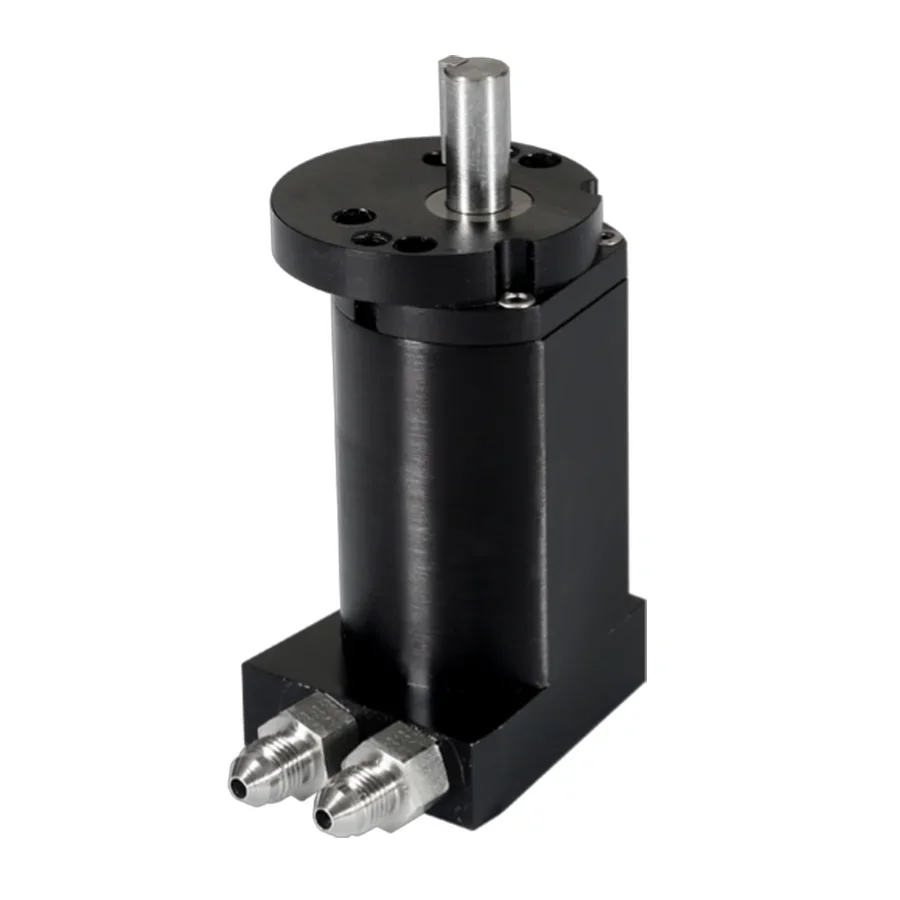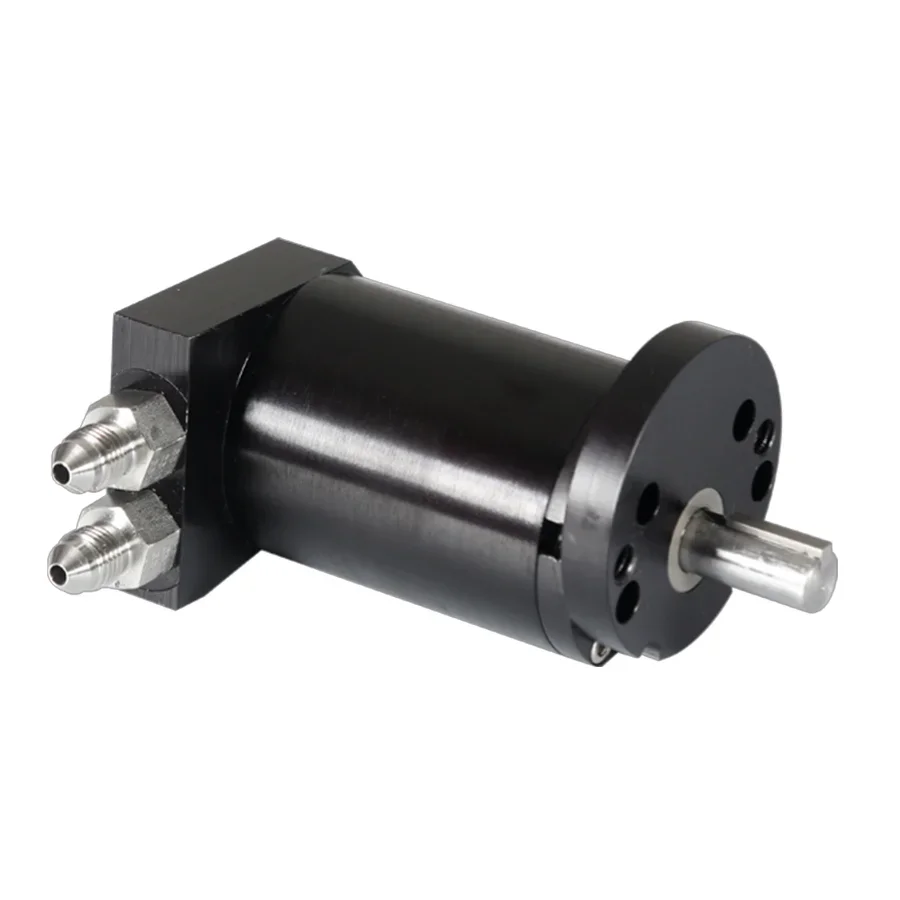Miniature hydraulic motors are compact powerhouses that pack a punch in a small package. These efficient devices provide robust performance in various applications, from robotics to aerospace. With their precise control and high power density, miniature hydraulic motors offer a reliable solution for demanding tasks. Their ability to deliver substantial power within limited space makes them indispensable in modern engineering projects. Whether it's intricate machinery or agile robotic systems, these motors excel in providing the necessary force and agility for optimal performance. Explore the world of miniature hydraulic motors and discover how these pint-sized components drive innovation across industries.
Understanding Miniature Hydraulic Motors
Compact Devices
Miniature hydraulic motors are small tools that transform hydraulic energy into mechanical energy. These devices are perfect for situations where there is limited space available. They are also ideal when weight needs to be kept at a minimum.
These motors can power various applications, including robotic arms, conveyor belts, and medical equipment. Their compact size allows them to fit seamlessly into these systems without adding bulk or weight.
-
Efficient use of limited space
-
Lightweight design suitable for various applications
Basic Principles
Understanding the fundamental concepts behind miniature hydraulic motors is crucial for their optimal performance. These motors operate based on the principles of fluid dynamics and mechanical engineering.
The basic components of a miniature hydraulic motor include an inlet port, outlet port, rotor, and stator. The rotor spins within the stator when fluid enters the motor through the inlet port. This rotational motion generates mechanical energy that powers the connected machinery.
-
Components: inlet port, outlet port, rotor, stator
-
Operational principle: fluid dynamics and mechanical engineering
Overview of Mini-Hydraulics Technology
Power Density
Miniature hydraulic motors are known for their high power density, meaning they can deliver a significant amount of power in a compact size. This is crucial in applications where space is limited, such as in small robotic arms or medical devices. The ability to generate substantial power within a small footprint makes these motors highly efficient and versatile.
Hydraulic systems leverage the incompressibility of fluids to transmit power effectively. In miniature hydraulic motors, this principle allows for precise control over speed and torque, making them ideal for applications requiring accurate movements. For example, in aerospace engineering, miniature hydraulic motors play a critical role in controlling landing gear mechanisms with precision and reliability.
Energy Transfer Efficiency
One of the key advantages of miniature hydraulic motors is their efficient energy transfer capabilities. By using fluids to transmit power, these systems minimize energy loss during operation compared to other mechanical systems like gears or belts. This efficiency not only leads to reduced energy consumption but also contributes to the overall performance and longevity of the equipment.
-
Pros:
-
High power density
-
Precise control
-
Efficient energy transfer
-
-
Cons:
-
Potential fluid leakage issues if not maintained properly
-
In robotics, miniature hydraulic motors enable robots to perform complex tasks with accuracy and speed due to their precise control capabilities. These motors are commonly used in robotic exoskeletons designed to assist individuals with mobility impairments by providing natural and fluid movements.
Industrial Applications
The versatility of mini-hydraulics technology has led to its widespread adoption across various industries. In aerospace, miniature hydraulic motors are integral components in aircraft systems like flight controls and landing gear mechanisms. These systems ensure safe and reliable operation during takeoff, flight, and landing processes.
-
Key Industries:
-
Aerospace
-
Robotics
-
Medical Equipment
-
Moreover, the medical field benefits from miniature hydraulic technology through advanced surgical equipment that requires precise movement control. From robotic-assisted surgeries to patient positioning systems, mini-hotorquedraulic motors enhance the accuracy and safety of medical procedures while improving patient outcomes significantly.
Types of Miniature Hydraulic Motors
Gear Motors
Miniature hydraulic systems often utilize gear motors due to their compact size and cost-effectiveness. These motors are commonly found in applications where space is limited but high efficiency is still required. Gear motors operate by using interlocking gears to transfer power, making them reliable for various small-scale operations. Despite their simplicity, gear motors can deliver a significant amount of power within a confined space, making them ideal for miniature hydraulic setups.
Gear Motors:
-
Compact and cost-effective
-
Reliable for small-scale operations
-
Deliver significant power in confined spaces
Vane Motors
Vane motors are another type of miniature hydraulic motor known for their smooth operation and high torque capabilities. These motors work by using vanes that slide in and out of rotor slots to create energy, resulting in a continuous rotary motion. Vane motors offer excellent efficiency and precision, making them suitable for applications requiring consistent performance. Their ability to provide high torque at low speeds makes vane motors advantageous in scenarios where controlled movements are essential.
Vane Motors:
-
Offer smooth operation and high torque
-
Provide excellent efficiency and precision
-
Ideal for applications requiring controlled movements
Piston Motors
Piston motors, the third type of miniature hydraulic motor, excel in providing an outstanding power-to-weight ratio. These motors use pistons within cylinders to generate mechanical energy efficiently, offering robust performance even in demanding environments. Piston motors are favored when high power output is necessary without compromising on weight or size constraints. Their ability to handle heavy loads while maintaining speed control makes piston motors suitable for challenging tasks that require both strength and precision.
Piston Motors:
-
Excellent power-to-weight ratio
-
Robust performance in demanding environments
-
Suitable for tasks requiring strength and precision

Components of a Miniature Hydraulic Power Pack
Reservoir
A miniature hydraulic power pack comprises essential components like a reservoir, pump, motor, valves, and filters. The reservoir is where the hydraulic fluid is stored to ensure continuous operation of the system. It acts as a storage tank for the fluid needed to drive the hydraulic system.
The reservoir in a miniature hydraulic power pack plays a crucial role in maintaining consistent pressure levels within the system. It ensures that an adequate supply of hydraulic fluid is available for smooth operation.
Pump and Motor
The pump in a miniature hydraulic power pack generates pressure necessary to drive the system. By converting mechanical energy into hydraulic energy, it enables the movement of fluids through the system. The motor, on the other hand, transforms this hydraulic energy back into mechanical energy to perform useful work.
In essence, these components work together seamlessly: while the pump generates pressure by moving fluid from the reservoir through the system's various parts, such as valves and actuators, the motor converts this pressured fluid back into mechanical motion or force.
Valves and Filters
Valves are critical components that control flow direction and regulate pressure within a miniature hydraulic power pack. They ensure that fluid flows smoothly through different parts of the system when needed and prevent any potential damage due to excessive pressure or uncontrolled flow.
Moreover, filters play an essential role in maintaining cleanliness within the hydraulic system by trapping contaminants present in the fluid. By removing impurities like dirt or debris, filters help prevent damage to sensitive components such as pumps and valves.
Introduction to Directional Valves in Miniature Hydraulics
Role of Directional Valves
Directional valves are vital components in miniature hydraulic motors systems. They control the flow direction of pressurized fluid, guiding it through the system to achieve specific tasks. By using these valves, operators can precisely manage the movement and speed of actuators or motors within a miniature hydraulic setup.
Directional valves ensure that hydraulic fluid travels along designated paths, allowing for seamless operation of various components. For instance, spool valves are commonly used to regulate the flow direction by moving a cylindrical piece inside a hollow core, while poppet valves use a ball or cone to control fluid movement. On the other hand, check valves permit fluid flow in one direction only, preventing backflow and maintaining system efficiency.
Types of Directional Valves
-
Spool Valves
-
Spool valves are prevalent in miniature hydraulic systems due to their ability to adjust flow paths by shifting a cylindrical component.
-
These valves offer precise control over the movement and rotation of actuators or motors based on their position within the valve body.
Poppet Valves
-
Poppet valves utilize a ball or cone mechanism to regulate fluid flow direction effectively.
-
Their design ensures quick response times and efficient operation in controlling pressurized fluids within miniature hydraulic setups.
Check Valves
-
Check valves play a crucial role in preventing reverse flow by allowing fluid movement in one direction only.
-
They maintain optimal pressure levels and enhance system performance by ensuring consistent delivery of pressurized fluids without interruptions.
Directional valves serve as gatekeepers for managing the intricate pathways through which pressurized fluids travel within miniature hydraulic systems. By utilizing different types such as spool, poppet, and check valves strategically, operators can achieve precise control over actuator movements and motor rotations with utmost efficiency and accuracy.
Exploring Accumulators in Miniature Hydraulic Applications
Functionality of Accumulators
Miniature hydraulic systems benefit from accumulators that store pressurized fluid. They play a crucial role in maintaining system stability by absorbing shocks and pressure fluctuations. For instance, in applications like miniature lifts, accumulators help provide a steady power supply to ensure smooth operation.
In emergency situations, accumulators act as a backup power source for critical functions within the hydraulic system. By storing pressurized fluid, they can offer immediate assistance when there is a sudden loss of primary power. This feature is vital for ensuring uninterrupted operation in scenarios where system failure could lead to safety hazards or operational downtime.
Types of Accumulators
There are various types of accumulators, each suited for specific application requirements in miniature hydraulic systems:
-
Bladder accumulators: These consist of an elastomeric bladder that separates the gas and fluid sections.
-
Piston accumulators: Utilize a piston to separate gas and fluid, offering high efficiency.
-
Diaphragm accumulators: Feature a flexible diaphragm to separate the gas and fluid sides effectively.
Each type has its advantages based on factors such as space constraints, pressure requirements, and operational conditions. For example, bladder accumulators are commonly used in applications where space is limited due to their compact design. On the other hand, piston accumulators are preferred for high-pressure applications due to their efficient energy storage capabilities.

Benefits of Using Miniature Hydraulic Motors
High Power Density
Miniature hydraulic motors have high power density, meaning they can generate a significant amount of power in a small and compact size. This feature is beneficial in applications where space is limited, such as in robotics or medical devices. Despite their small stature, these motors can deliver impressive performance, making them ideal for various industries that require efficient power sources.
Miniature hydraulic motors are designed to provide precise control over speed and torque, allowing for accurate movements in machinery and equipment. This level of control is crucial in applications that demand precision, like automated manufacturing processes or intricate mechanical systems. By utilizing miniature hydraulic motors, manufacturers can ensure consistent and reliable operation in their equipment.
Operating in Extreme Conditions
One of the key advantages of miniature hydraulic motors is their ability to function effectively in extreme conditions. These motors are capable of operating at high temperatures without compromising performance, making them suitable for applications exposed to heat-intensive environments. Miniature hydraulic motors excel in harsh conditions where other types of actuators may struggle to maintain efficiency.
-
Pros:
-
High power density
-
Precise control capabilities
-
Ability to operate under extreme conditions
-
-
Cons:
-
Initial cost may be higher than other motor types
-
Efficiency and Reliability
Miniature hydraulic motors are renowned for their efficiency and reliability, offering consistent performance over extended periods. Their design minimizes energy loss during operation, maximizing overall efficiency in various applications. Moreover, these motors have fewer moving parts compared to traditional electric motors, reducing the risk of mechanical failures and enhancing long-term reliability.
These compact yet powerful devices boast an impressive long service life, requiring minimal maintenance throughout their operational lifespan. The durability of miniature hydraulic motors makes them a cost-effective solution for businesses looking to minimize downtime and reduce maintenance expenses associated with machinery upkeep.
Applications of Miniature Hydraulic Motors
Various Industries
Miniature hydraulic motors are versatile and find applications in different industries such as aerospace, automotive, robotics, and medical equipment. They play crucial roles in powering various mechanisms across these sectors. For instance, in the aerospace industry, they are used to operate aircraft flaps for smooth takeoffs and landings.
In the automotive sector, hydraulic motors contribute to functions like power steering systems that make driving easier for individuals. Furthermore, these motors are integral components of robotic arms in manufacturing settings where precision and control are paramount. Miniature hydraulic motors are utilized in conveyor systems to ensure seamless movement of goods within warehouses.
Compact Spaces
One significant advantage of miniature hydraulic motors is their ability to provide reliable power transmission in compact spaces where other technologies might not be suitable. Due to their small size yet high efficiency, these motors can fit into tight areas without compromising on performance. For example, surgical instruments require precise movements within limited spaces during procedures; miniature hydraulic motors enable this intricate movement with ease.
In comparison to larger hydraulic systems or electric motors which may not be practical due to size constraints or power limitations in confined environments, miniature hydraulic motors offer a compact solution without sacrificing power output. This makes them ideal for applications where space is limited but reliable movement is essential.
Choosing the Right Miniature Hydraulic Motor
Torque Requirements
Miniature hydraulic motors need to meet specific torque requirements based on the application. Higher torque is needed for heavy-duty tasks like robotic arms, while lower torque suffices for lighter applications such as conveyor belts.
Hydraulic motors with adjustable displacement can provide varying levels of torque, offering flexibility in different scenarios. Consulting with experts can help determine the appropriate torque needed for a particular application.
Speed Range and Space Limitations
Consider the speed range required for your miniature hydraulic motor. Some applications demand high speeds, while others may need slower, more controlled movements.
Space limitations are crucial when choosing a miniature hydraulic motor. Compact designs are essential to fit into tight spaces without compromising performance or efficiency.
When selecting a motor, ensure it strikes a balance between power and size to meet both speed requirements and space constraints effectively.
Cost-Effectiveness and Durability
Evaluate the cost-effectiveness of miniature hydraulic motors by considering not only the initial purchase price but also long-term maintenance costs. Opting for good quality products may be slightly pricier initially but can lead to cost savings over time due to reduced maintenance needs.
Durability is paramount in ensuring that the motor withstands continuous use without frequent breakdowns or replacements. Look for models known for their longevity and reliability to avoid unexpected downtime or repair expenses.

Closing Thoughts
In conclusion, the exploration of miniature hydraulic motors has shed light on their intricate design, diverse applications, and significant advantages in various industries. Understanding the types of miniature hydraulic motors, components of power packs, directional valves, and accumulators is crucial for optimizing their performance in different settings. The benefits they offer, such as high power density, precise control, and reliability, make them indispensable in modern engineering solutions.
To delve deeper into the realm of miniature hydraulic motors, individuals are encouraged to explore further resources and engage with experts in the field. By staying informed about the latest advancements and applications, one can harness the full potential of these compact yet powerful devices. Embracing innovation and continuous learning will undoubtedly pave the way for enhanced efficiency and productivity in hydraulic systems.
Frequently Asked Questions
What are miniature hydraulic motors commonly used for?
Miniature hydraulic motors are often utilized in applications where space is limited but high power density is required. They are commonly found in robotics, medical devices, aerospace equipment, and automation systems due to their compact size and efficient power delivery.
How do miniature hydraulic motors differ from standard hydraulic motors?
Miniature hydraulic motors are designed to operate in small spaces with lower flow rates and pressure requirements compared to standard hydraulic motors. They offer precise control, high efficiency, and can be integrated into intricate systems where space is a premium.
What factors should be considered when choosing a miniature hydraulic motor?
When selecting a miniature hydraulic motor, key factors to consider include the required torque output, speed range, physical dimensions for installation constraints, efficiency levels needed for the application, as well as compatibility with the overall system design and operational environment.
Are there specific maintenance requirements for miniature hydraulic motors?
Regular maintenance tasks for miniature hydraulic motors typically include monitoring fluid levels, checking for leaks or damage in hoses and fittings, inspecting seals for wear or deterioration, ensuring proper filtration of fluids to prevent contamination issues that may affect performance or longevity of the motor.
Can miniature hydraulic motors be customized for specific applications?
Yes, many manufacturers offer customization options for miniature hydraulic motors to meet unique specifications of different applications. Customization may involve modifications in terms of mounting configurations, shaft designs, sealing options or integration of additional features tailored to specific industry requirements.
